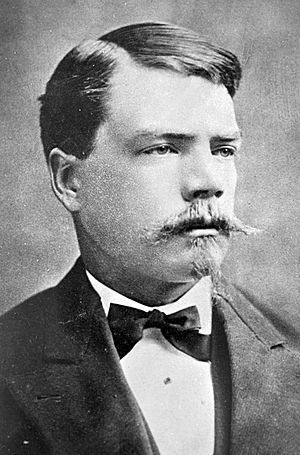James Ezekiel Porter facts for kids
Quick facts for kids
James Ezekiel Porter
|
|
|---|---|

James Porter
|
|
| Born | February 2, 1847 Strong, Maine |
| Died | June 25, 1876 (aged 29) Montana |
| Place of Burial |
Strong Village Cemetery
Strong, Maine |
| Allegiance | United States of America |
| Service/ |
United States Army |
| Years of service | 1869–76 |
| Rank | First Lieutenant |
| Unit | 7th U.S. Cavalry |
| Battles/wars | American Indian Wars |
James Ezekiel Porter (born February 2, 1847 – died June 25, 1876) was a brave officer in the United States Army. He served under General Custer and was one of the officers who died at the famous Battle of the Little Bighorn. This battle is also known as Custer's Last Stand. Historians believe Porter helped lead his troops in a defensive fight during the battle. He also served in the southern United States after the Civil War, during a time called the Reconstruction Era. His unit, the 7th U.S. Cavalry, helped keep peace and stop illegal activities.
Contents
Who Was James Porter?
James Ezekiel Porter was born in Strong, Maine, in 1846. His father, Jeremy W. Porter, made wood products. He was also a state senator, which means he helped make laws for the state.
James Porter's Education
James Porter went to Bates College from 1862 to 1863. Then, he attended Norwich University from 1863 to 1864. After that, he was chosen to attend the United States Military Academy at West Point. This is a very famous school for training army officers. Porter graduated from West Point in 1869. He was ranked 16th in his class of 39 students. Many officers in the 7th Cavalry, like Porter, came from educated families.
What Was James Porter's Military Career Like?
After graduating, James Porter became a second lieutenant in the U.S. 7th Cavalry Regiment. His first assignments were at forts in Kansas, like Fort Leavenworth.
Serving in the Plains and the South
From 1869 to 1876, Porter was involved in conflicts with Native American tribes on the Great Plains. He also served in the southern United States after the Civil War. This period was called the Reconstruction Era. The 7th Cavalry was tasked with keeping order and stopping groups like the Ku Klux Klan. Porter served in various cities, including Chester, South Carolina, and Louisville, Kentucky. A fellow soldier praised Porter for his "energy and discretion" during this time.
Promotions and New Assignments
In 1872, Porter was promoted to first lieutenant. He was assigned to Troop I. Later, he was sent back to forts in Dakota, like Fort Abraham Lincoln. In 1873 and 1874, he worked on the Northern Boundary Survey, which mapped the border. Before the Battle of Little Bighorn in 1876, Porter wanted to transfer to a different role. He hoped for a more stable life because his wife had just given birth to their second child. They had moved 14 times during his service. When Captain Myles Keogh went to Ireland in 1874, Porter took command of Company I.
How Did James Porter Die at Little Bighorn?
On June 25, 1876, James Porter was likely killed by the Sioux during the Battle of the Little Bighorn. He was fighting under the command of General Custer.
Porter's Role in the Battle
Historians believe Lieutenant Porter played an important role in the battle. He helped position his troops, Troop "I," to defend against the Native American warriors. This action forced the warriors to seek cover. Porter's Company I was stationed on the east side of Custer Ridge. They were either in reserve, helping other troops, or trying to break out of the battle.
The Mystery of Porter's Body
After the battle, on June 27, 1876, soldiers found some clues about Custer's defeat. They found Lieutenant James Porter's buckskin jacket in an abandoned Native American village. It had a bloody hole near the heart. Some people thought Porter's head was also found, but this is not certain.
Modern experts believe that Porter's body was one of three officers' bodies that were never fully identified. The other two were James G. Sturgis and Henry M. Harrington. Even though his jacket confirmed his death, his body was not clearly found. General Philip Sheridan ordered his brother, Lieutenant Colonel Michael Sheridan, to find and properly bury the officers' bodies. In 1910, a stone marker was placed for Lieutenant Porter at the battlefield, even though the exact spot of his death was unknown.
What Is James Porter's Legacy?
James Porter left behind his wife, Eliza Frances Westcott, and two children. Before the battle, Captain Myles W. Keogh gave his personal papers to Eliza Porter. He asked her to burn them if he died.
Honors and Memorials
In 1882, the U.S. Congress gave Eliza Porter a special pension. This was more money than usual because of her husband's death at Little Bighorn. Eliza Porter lived in San Jose, California, and died in 1915.
Besides the marker at the Little Bighorn Battlefield, there is a memorial for Porter in his hometown of Strong, Maine. This memorial is called a cenotaph, which is a monument for someone buried elsewhere. It mentions his death at Custer's Last Stand. A large ceremony was held for Porter at the Congregational church in Strong, Maine, after his death.
A coast artillery battery at Fort Hunt in Virginia was named Battery Porter in his honor in 1903. Also, a group called the James E. Porter Post of the Grand Army of the Republic in Weld, Maine, was named after him. One of Porter's personal revolvers, a Smith & Wesson, is now in the collections at the Little Bighorn Battlefield National Monument. James E. Porter has also been featured as a character in several historical novels.


